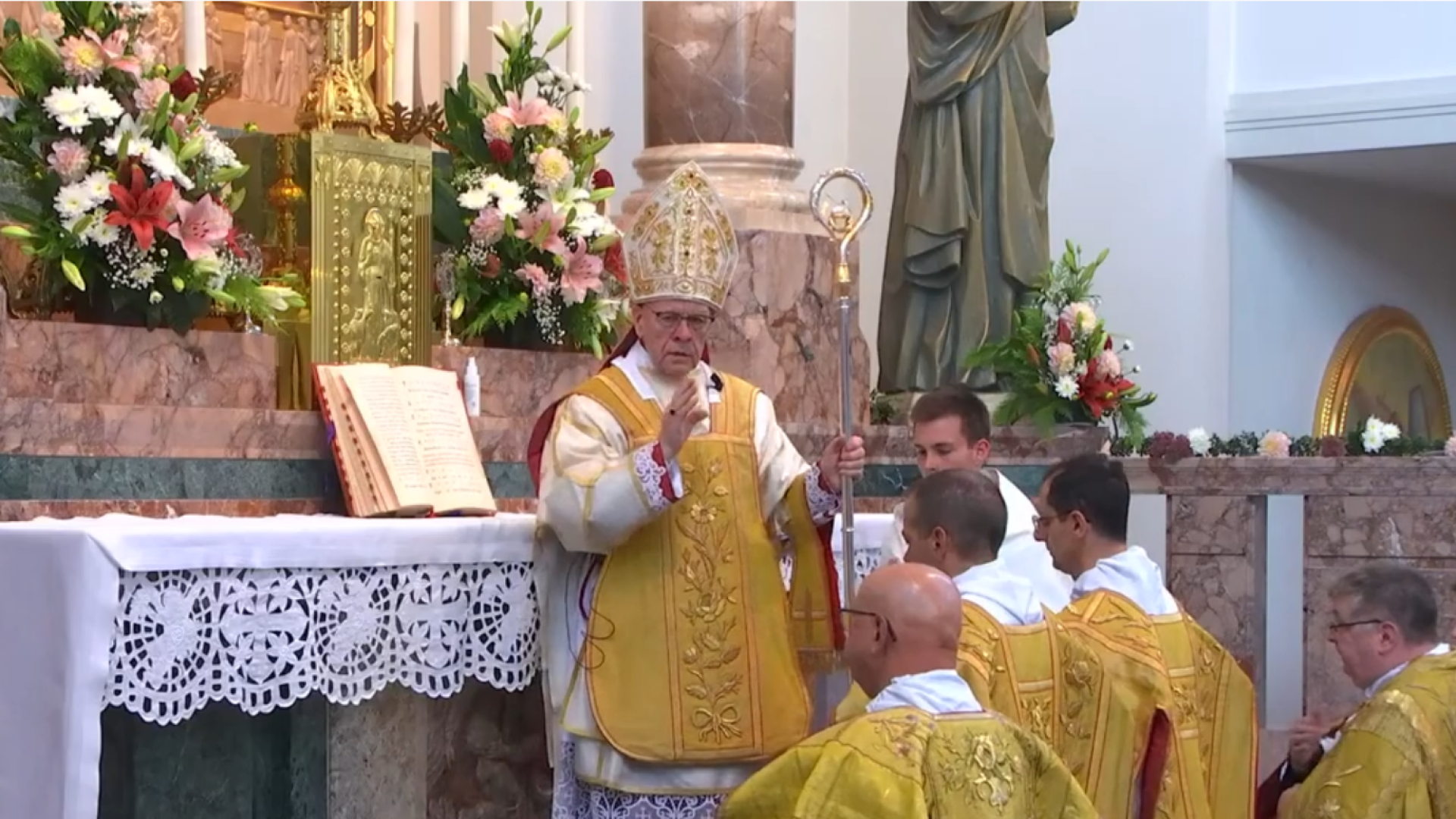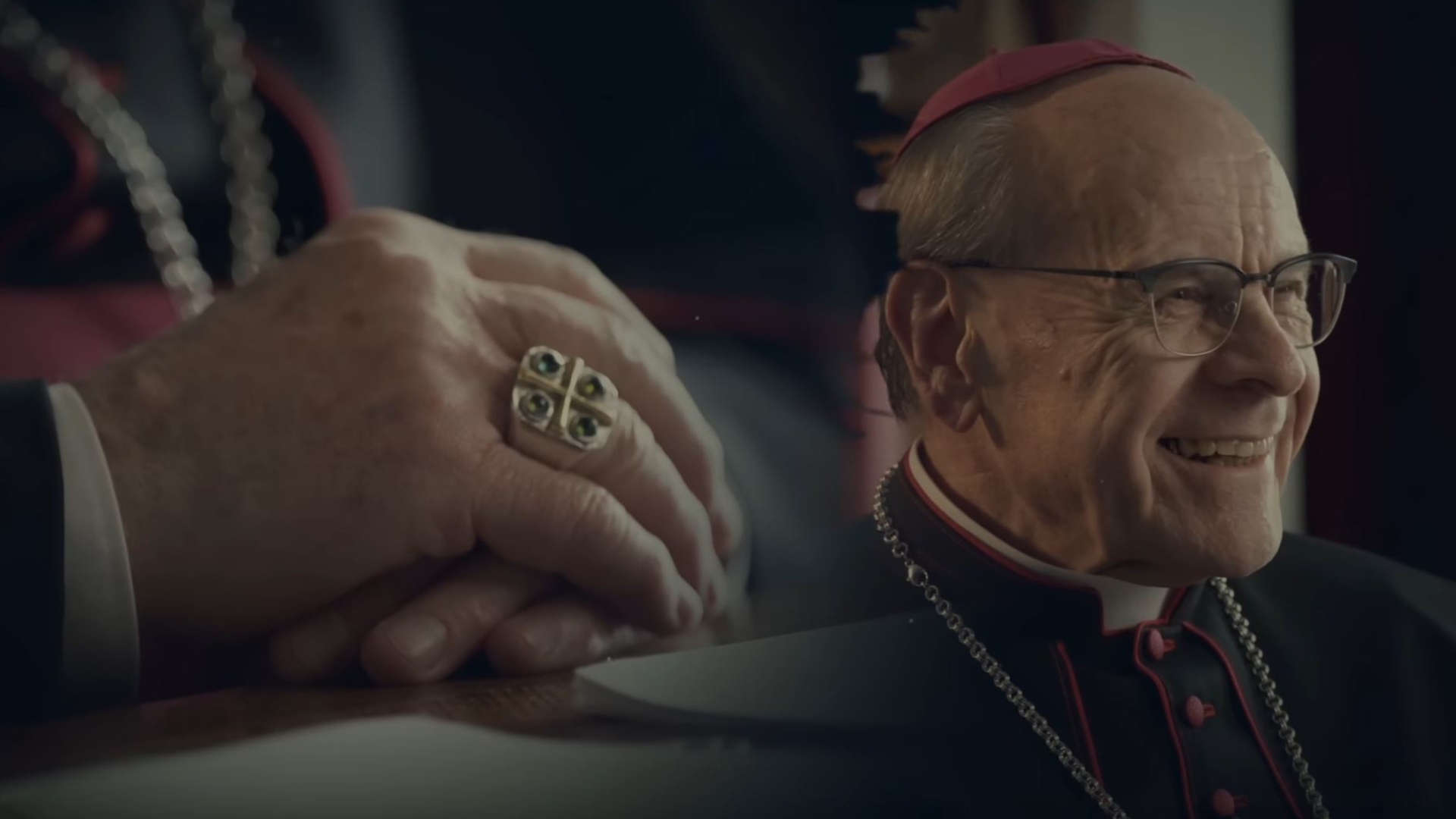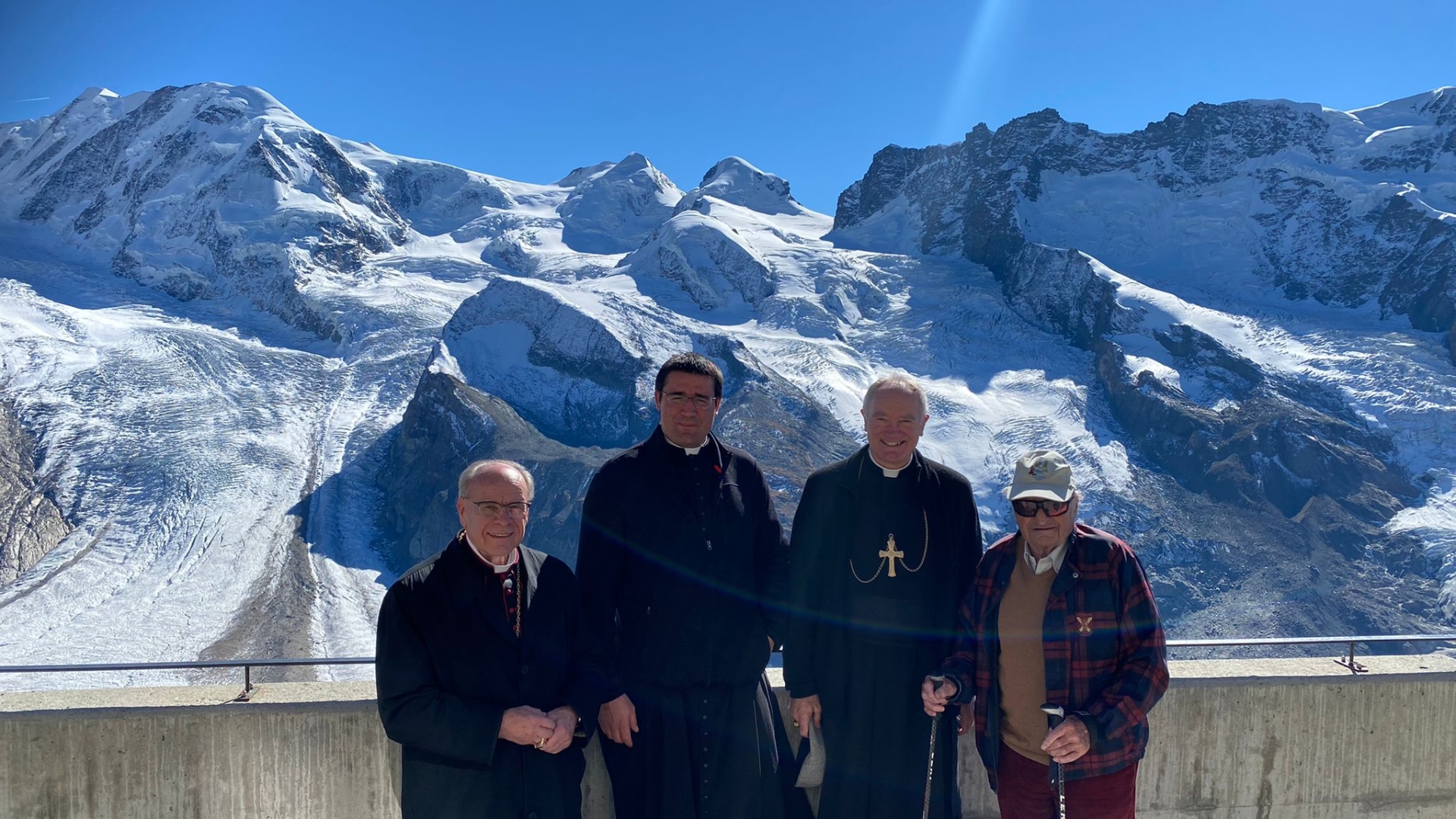Bishop Vitus Huonder and the SSPX

Bishop Huonder giving the blessing at the end of his Jubilee in the church of Wil
Bishop Vitus Huonder, who passed away on Easter Wednesday, will be buried in his former diocese of Chur, but at Écône. This choice was communicated to the diocese in 2022, then reiterated orally to Bishop Joseph Maria Bonnemain of Chur and Fr. Davide Pagliarani, Superior General of the Society of Saint Pius X (SSPX), a few days before Bishop Huonder's death. He wanted to be buried alongside Archbishop Marcel Lefebvre, who suffered so much for the Church.
The Path To the SSPX
It was at Rome’s request that Bishop Huonder began to discover the Society. Here is how he talked about it during his interview on the Certamen YouTube channel:
“By a letter dated January 9, 2015, I received the order to start a dialogue with representatives of the Society of Saint Pius X. The letter came from the then Prefect of the Roman Congregation for the Doctrine of the Faith, Cardinal Gerhard Müller. The idea was to create a friendly-interpersonal relationship with the community. At the same time, the doctrinal questions of the Church were to be addressed. These were questions related to the documents of the Second Vatican Council (1962-1965), as well as questions related to the Roman pronouncement of previous years. Special mention was to be made of questions concerning the liturgy, specifically regarding the authentic Roman Holy Mass. Further topics concerned the understanding of the Church, ecumenism, the relationship between Church and state, interreligious dialogue, and religious freedom. Since April 9, 2015, this mandate has led to regular contact with the SSPX, with the superior general as well as with other representatives.”
These contacts allowed Bishop Huonder to know the Society from the inside and not according to the image given by the media. They also gave him the opportunity to become familiar the writings of Archbishop Marcel Lefebvre and study in depth the doctrinal reasons for the fight the Archbishop led from the Council until his death.
“As these contacts progressed, I delved into the biography and the writings of the founder of the SSPX, Archbishop Marcel Lefebvre. I thus became more and more familiar with the theological arguments, the concerns, and the objectives of the SSPX.”
Thus, in 2019, when it was necessary to end his service as diocesan bishop, Bishop Huonder asked to be able to spend his final years at the Sancta Maria Institute in Wangs, which the Ecclesia Dei Commission explicitly encouraged him to do.

Lying in state at the Sancta Maria Institute
from Thursday April 4 to Tuesday April 9, from 6:30 a.m. to 9:00 p.m. and a rosary for the deceased every day at 6:30 p.m.
Lying in state in the Oberriet church
from Thursday April 11 to Monday April 15, from 6:30 a.m. to 9:00 p.m.
Funeral at the Écône seminary church
Wednesday April 17, at 9:30 a.m., burial in the seminary vault.
The Crisis of Faith
These contacts with the SSPX gave Bishop Huonder a new outlook and led him to make a real retraction.
“Through contact with the SSPX, the study of its history and the deepening of theological questions, I have a new perspective. It is a new view on the past 70 or 80 years of the Church's life. We can speak of a retractatio, of a new judgment of the state of the Faith at the time of the Council and afterwards. It became clearer to me why the Church has come to where it is today. Today, in 2023, the Church is in one of the greatest crises of her history. It is an internal crisis that covers all areas of the Church’s life: preaching, liturgy, pastoral care, and government. It is a deep crisis of faith. Anyone who delves into the historical development and the life of the SSPX involuntarily encounters the cause and the roots of this crisis. For the SSPX is, in a certain sense, a child of this crisis. It is so insofar as its founder wanted to react to the crisis by setting up this institution and thus help the Church.”
The Crisis of the Mass
He also discovered that at the very heart of this crisis of faith lies the drama of Calvary. Now celebrating the Holy Mass of all time every day (as Archbishop Lefebvre liked to say), Bushop Huonder discovered that the Mass is not only a liturgical act, but also a profession of faith, the Faith of all time.
“The traditional Roman liturgy is equivalent to a creed. Its substance must not be changed. Thus it cannot be banned. Pope Pius V didn't create anything new. Rather, he affirms the legitimacy of the exercise of faith in this form of liturgy. He confirms the authenticity of this faith. The faithful can never be deprived of such a good. What happened after the Second Vatican Council with the intended abolition of the traditional rite of the Mass is an injustice, an overstepping of authority.”
The Crisis in the Church
From that point on, Bishop Huonder perceived with great clarity the reality of the Church’s situation. He did not hesitate to speak about it publicly, both during sermons and during interviews broadcast via the Internet. Here is what he confided to Certamen:
“Today, in 2023 – I would like to come back to that – the Church is in one of the greatest crises in its history. It is a crisis within the Church. It covers all areas of the life of the Church: proclamation, liturgy, pastoral care, and government. It is a deep crisis of faith. That was our finding. Now the question: How can this crisis be overcome? Let it be said straight away, there is only one way out of the crisis: a return to those values and beliefs that one has abandoned or neglected or unlawfully discarded. The aim is to process the development of the past 70 years and to subject it to a revision. The Church needs renewal in her head and members. In particular, it requires the renewal of the hierarchy, the renewal of the episcopate, and urgently a return to sacramental and liturgical life. Sacramental life and the priesthood – hierarchy – are closely related.”
Related Article:
Bishop Huonder during the pilgrimage to Flüeli, in 2023
The Great Wound
Pope Benedict XVI had the courage to declare that the traditional Mass had in fact never been prohibited. But his successor revoked the motu proprio Summorum Pontificum by the measures set forth in Traditionis Custodes. Here is how strongly Bishop Huonder judged these measures against the traditional liturgy:
“[These] measures are nothing other than a hunt against those faithful who have reason to recognize in this liturgy the true and original worship of the Roman Church. It is unabashedly disregarded that they have a right to receive the sacraments in the form that has been passed down through the centuries. It is the same audacity that prevailed after the Council and that caused so much suffering at the time.”
And in a moving plea, Bishop Huonder addressed the Holy Father himself:
“I would like to ask the Pope why he takes the bread away from the children?
What prompts him to let them starve? What prompts him to let them perish? Because they have a right to this sustenance – I emphasize: to this sustenance – I emphasize: they have a right. It is the sustenance that their fathers ate and passed on to them. It's not their own recipe. They didn't put it together themselves – arbitrarily, so to speak. They accepted it from those who had faithfully passed it on. Why is the Pope taking it away from them and letting them starve? Why does he want to force them into something that is foreign to them? Our Lord said: Or what man is there among you, of whom if his son shall ask bread, will he reach him a stone? Or if he shall ask him a fish, will he reach him a serpent? (Mt. 7:9-10 and Lk. 11:11-12). The point here is not even that the Pope gives something, but that he takes something away from his children, something vital: the Holy Sacrifice of the Mass of the Fathers.”
Related Article:

Interview with Certamen
A Demand for Justice
“Defunctus adhuc loquitur – The deceased still speak.”
These words of St. Paul to the Hebrews can be applied to the Bishop Huonder following his passing. Here is in fact the conclusion that he himself drew from his discovery of the SSPX:
“I come back to January 9, 2015, to the Roman letter ordering the opening of talks with representatives of the SSPX. Despite adverse circumstances, I have fulfilled this mandate – and am still in the process of fulfilling it. So I would like to close with a request to Church authorities. I seek justice for the Society of Saint Pius X. The study of their situation calls for this petition. It would be fitting for the Church to offer, as in other cases, an apology to this Society. This has even been done in cases of phantom graves. This is not about phantoms, but about living people, about souls who have a right to the pastoral care that was granted them by the Church before the Council and that continues to exist afterwards as a permanent claim. It's not about a privilege or an indult; it's about a right.
“It would do well for Church authorities to express, together with this apology, their gratitude for the work of the SSPX, and to express their appreciation of this deeply Catholic work without any ifs or buts.”
Related Article:

Bishop Vitus Huonder at Zermatt
(Source : District de Suisse - FSSPX.Actualités)





